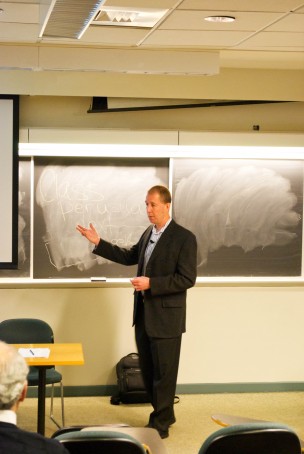On April 8, Ron Bloom ’77 returned to discuss his time as 'Auto Czar' and a representative Detroit’s retirees during its bankruptcy crisis.
Ron Bloom ’77 visited campus on Thursday, April 8, to discuss his involvement in General Motors’ bankruptcy declaration in 2009 and the city of Detroit’s similar declaration in 2013. He attended three meetings with students and faculty during the day. First, he met with Professor of History Ronald Schatz’s class, HIST 266: American Labor History from 1776 to Recent Times and later that afternoon he joined a small group in the Woodhead Lounge to discuss his career. Finally, in the evening he delivered a talk titled “We Almost Lost Detroit: A Hopeful Tale About Cars, Crises, Cities, and America.”
The day’s events were organized by the Allbritton Center for the Study of Public Life and its director, John E. Andrus Professor of Sociology Rob Rosenthal.
“One of the things I do is I reach out to important people in public life and see if they’re interested in coming here, which is easier if they’re alums themselves,” Rosenthal said.
Bloom completed his undergraduate degree at the University before earning an MBA in 1985 from the Harvard Graduate School of Business Administration. He served as the assistant to the President of United Steelworkers before joining the Obama Administration as the senior advisor to the Secretary of the Treasury on the President’s Task Force on the Automotive Industry, commonly called the “auto czar.” Presently, Bloom is the vice chairman of U.S. Investment Banking for Lazard, a financial advisory and asset management firm.
“This is really an important guy,” Rosenthal said. “I don’t know if Time is right or wrong, but they think he’s one of the hundred most influential people in the world, that’s…pretty important…. And he has a fantastic story to tell, I thought. In part, because the different things that he’s doing have overlapped. The car stuff, which in itself would be interesting…but then, the fact that he’s gone on to serve in Detroit—and the automobile industry is located in Detroit—make the whole thing so much more interesting.”
The first half of his evening lecture focused on his role in the 2009 government bailout of General Motors (GM). Bloom stressed that the federal government deemed this bailout the appropriate step to take for the sake of the 50,000 autoworkers that would have otherwise lost their jobs and benefits. Additionally, retired workers were at risk for losing their pensions and healthcare. He addressed the criticism that he and his task force had heavily favored the autoworkers.
“What those critics failed to note is it’s really tricky to make cars without workers,” Bloom said. “So what the [United Auto Workers] union did, which is what everyone does in a private-sector bankruptcy case, is they used their leverage…. That’s what everybody does. So, people have insisted we put our thumb on the scale, tilted the scale in favor of the union. It is not true that we did that, [but] it is true that the circumstances of the situation dictated that.”
According to Bloom, it is incredibly rare for the federal government to own the majority of a private corporation, and it left the government in precarious position.
“GM was nationalized; in a strict interpretation of the word, that’s what happened,” Bloom said. “The national government owned a majority stake in General Motors. So the question is, ‘Now you own it, what are you going to do with it?””
In the end, the task force and the Obama administration decided to dramatically scale back their involvement with the corporation. This decision allowed them to avoid a potential conflict of interest, as the federal government sets the regulatory standards for automobiles.
“So we resolved the dilemma in favor of a very heavy hand for a very short period of time,” Bloom said. “The other observation I would make…is we had in what we did far, far more degrees of freedom than the government normally has. In a crisis, people are prepared to grant their government a far greater set of flexibilities.”
Since GM declared bankruptcy at the start of the economic crisis, they were able to receive government assistance. However, Bloom pointed out, the federal government was not in the same position to assist the city of Detroit when it declared bankruptcy in 2013.
Bloom presented statistics from 1950 and 2010 that demonstrate Detroit’s slow decline from America’s wealthiest city with a booming auto industry to a depressed city with a murder rate 10 times the national average.
By this time, Bloom had left the Obama administration and was working in New York with Lazard. The firm was hired by a group of retirees to represent their interests in the process. Among the many financial troubles facing the city were the pensions and health benefits of 30,000 retired workers.
“Our job was to sort through both the economics and politics of Detroit,” Bloom said. “It’s a little bit about economics, but it’s really about politics.”
In the end, the retirees opted to accept a 1.5 billion-dollar revitalization plan. It led to cuts in their pensions, but did provide a compromise.
Attendee Joel Michaels ’18 found Bloom’s story compelling.
“He did a really good job of contextualizing the circumstances behind the GM ballot, and why Detroit didn’t get any financial help,” Michaels wrote in an email to The Argus. “But even more fascinating was his discussion of who gets repaid in a bankruptcy situation…on a pure moral level, where should resources go? To the former municipal employees who’ve earned their pensions, or the actual residents of a city who deserve social services?”
Today, the population of Detroit has held stable for two years, and Bloom is hopeful about the future.
“The people of Detroit are wise enough to pick the best guy in the time of crisis,” Bloom said.
